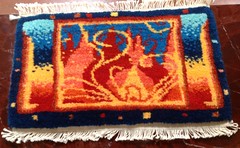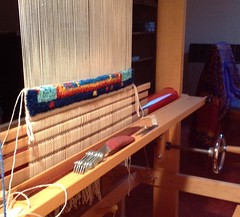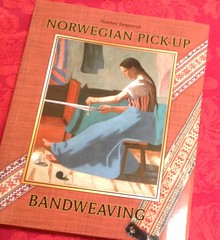Totally Random
Book winner! #16 :) Congratulations "Shirley, surely!" Send me your address, (sara at saralamb dot com) and I'll drop the book in the mail. Thanks for all your comments, and I do hope you all get a chance to read this book.
For the several of you who requested the link to the buy the book, it's in the previous post (link above, click on Schiffer Publishing), or go here. This book will be a classic, it should be on your bookshelf if you are at all interested in textile history, traditional weaving techniques, or bandweaving in general. Heather has done a lovely job of presenting the materials, and I wish her all the success with this book.
This week I was able to attend a lecture in Boulder CO given by Linda Ligon, founder and creative director of Interweave Press, and now a principal in Cloth Roads, a resource for global textiles. Linda's talk, which launched a new book by Thrums Books, was held at Shuttles, Spindles and Skeins, a yarn shop in Boulder. I met up with many people I had not seen in quite a while. It was a treat to see old friends, talk about textiles and their makers, and once again be among people who consider cloth and textiles worthy of study.
We textile enthusiasts are so often dismissed, or worse, overlooked in the general population. Who even thinks about the textiles that surround them? So much in our world today is made of petroleum by-products, including the plastics that make up the bulk of what is sold for clothing, upholstery, household textiles and carpets. Natural fibers are renewable resources. They do not melt in a fire, or off-gas noxious fumes. They moderate temperatures, and grow more comfortable with use. But they are becoming increasingly overshadowed by synthetics: acrylics, polyester, nylon, even rayon and bamboo.
These two publishing companies, Schiffer and Thrums, along with import companies like Cloth Roads, champion the people, the natural fibers of the world, the techniques and textile communities, worldwide and historical, that keep textile traditions and practices alive. They educate us, inform us, keep us abreast of what is happening in far off communities where weaving is a way of life, for subsistence and for artistic expression. I am so thankful that they are able to bring us this information, these textile examples, and that we can still travel to meet people and learn about what they do. Linda's lecture gave us a glimpse of Chiapas, this time, where will she take us next?
Many thanks to those who made my visit possible: Gram and Grandpa Dick, the women at Shuttles, and Cloth Roads, and the weaving community of Boulder who attended with me. It was a lovely break in the middle of a week of childcare, and a reminder of why I do all this textile stuff: the people, the friends, the daily practice of textiles, and the value of keeping these traditions alive.
For the several of you who requested the link to the buy the book, it's in the previous post (link above, click on Schiffer Publishing), or go here. This book will be a classic, it should be on your bookshelf if you are at all interested in textile history, traditional weaving techniques, or bandweaving in general. Heather has done a lovely job of presenting the materials, and I wish her all the success with this book.
This week I was able to attend a lecture in Boulder CO given by Linda Ligon, founder and creative director of Interweave Press, and now a principal in Cloth Roads, a resource for global textiles. Linda's talk, which launched a new book by Thrums Books, was held at Shuttles, Spindles and Skeins, a yarn shop in Boulder. I met up with many people I had not seen in quite a while. It was a treat to see old friends, talk about textiles and their makers, and once again be among people who consider cloth and textiles worthy of study.
We textile enthusiasts are so often dismissed, or worse, overlooked in the general population. Who even thinks about the textiles that surround them? So much in our world today is made of petroleum by-products, including the plastics that make up the bulk of what is sold for clothing, upholstery, household textiles and carpets. Natural fibers are renewable resources. They do not melt in a fire, or off-gas noxious fumes. They moderate temperatures, and grow more comfortable with use. But they are becoming increasingly overshadowed by synthetics: acrylics, polyester, nylon, even rayon and bamboo.
These two publishing companies, Schiffer and Thrums, along with import companies like Cloth Roads, champion the people, the natural fibers of the world, the techniques and textile communities, worldwide and historical, that keep textile traditions and practices alive. They educate us, inform us, keep us abreast of what is happening in far off communities where weaving is a way of life, for subsistence and for artistic expression. I am so thankful that they are able to bring us this information, these textile examples, and that we can still travel to meet people and learn about what they do. Linda's lecture gave us a glimpse of Chiapas, this time, where will she take us next?
Many thanks to those who made my visit possible: Gram and Grandpa Dick, the women at Shuttles, and Cloth Roads, and the weaving community of Boulder who attended with me. It was a lovely break in the middle of a week of childcare, and a reminder of why I do all this textile stuff: the people, the friends, the daily practice of textiles, and the value of keeping these traditions alive.



